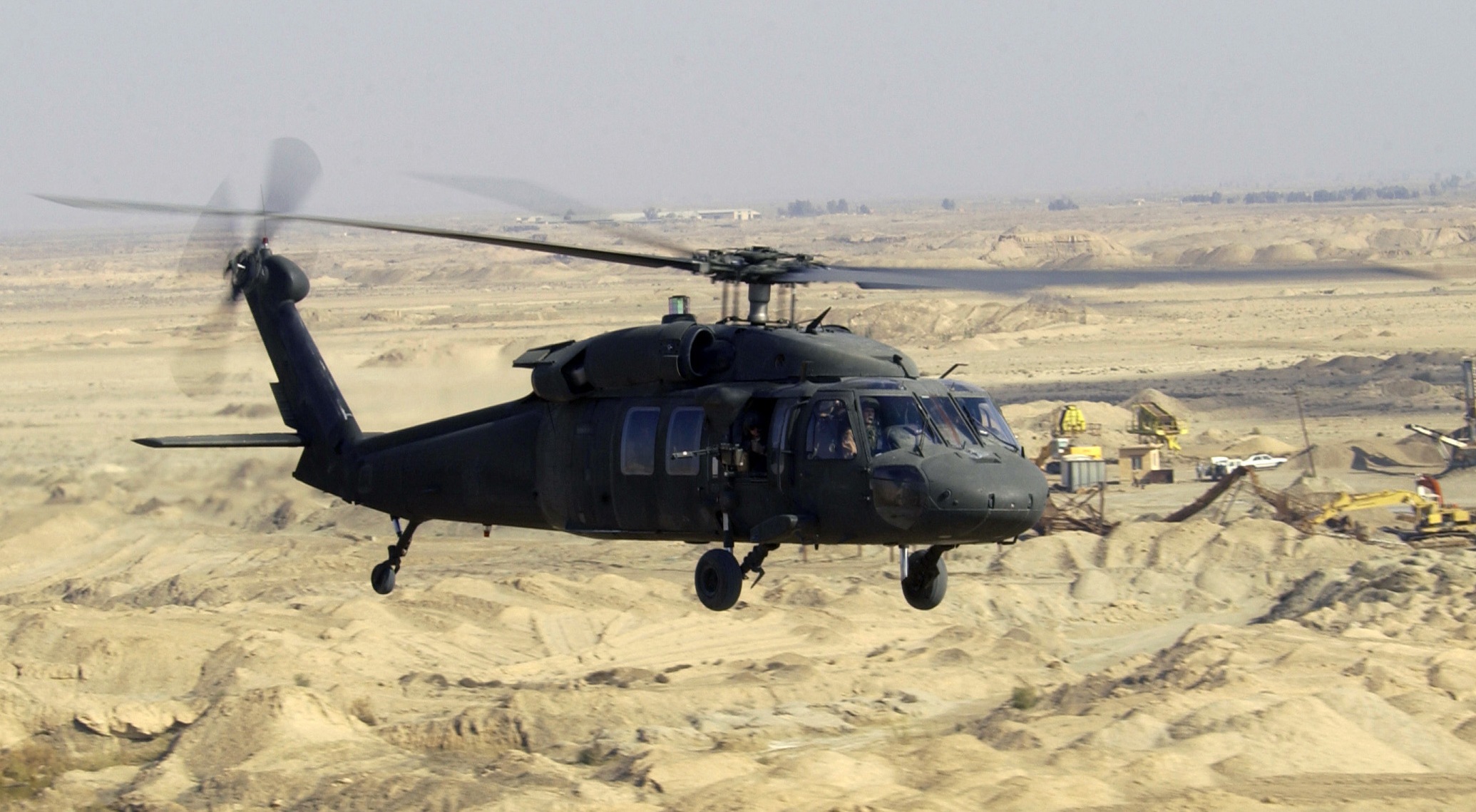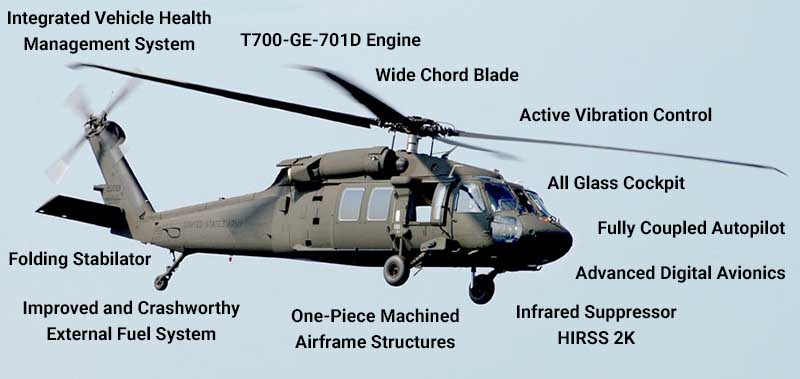UH-60: Innovations in Modern Helicopter Layout
The UH-60 helicopter stands as a benchmark in contemporary aeronautics, showcasing significant improvements in layout and technology that cater to the progressing needs of military operations. As we discover the advancement and essential advancements of the UH-60, it comes to be important to think about how these growths affect not just current applications however likewise the future landscape of helicopter layout.

Advancement of the UH-60
The development of the UH-60 Black Hawk helicopter stands for a considerable turning point in aerospace engineering and army air travel. Presented in the late 1970s, the UH-60 was created by Sikorsky Aircraft to fulfill the United States Army's requirement for a flexible utility helicopter efficient in carrying out a variety of objectives. Its design stressed rate, resilience, and ability to move, setting brand-new standards for operational efficiency.
The UH-60 features an unique four-blade blades system, which improves lift and security, permitting it to operate properly in diverse atmospheres. Its airframe is created from advanced composite products, adding to a reduction in weight while preserving architectural integrity. The helicopter's layout likewise includes better aerodynamics, which improves gas performance and enhances variety.
For many years, the Black Hawk has undertaken multiple upgrades to improve its abilities, consisting of boosted engines, advanced flight control systems, and modular systems for easy maintenance and versatility. The helicopter's ability to perform goals ranging from troop transport to medical emptying has actually strengthened its duty as a foundation of united state army procedures. The UH-60 Black Hawk continues to be an archetype of how development in helicopter style can dramatically influence army performance and functional adaptability.
Advanced Avionics Equipments
Innovations in avionics systems have transformed the capacities of modern-day helicopters like the UH-60 Black Hawk, enhancing functional performance and situational recognition (UH 60). The integration of advanced avionics permits for enhanced navigation, trip, and interaction administration, making the UH-60 much more functional in varied objective profiles
Among the vital functions is the sophisticated digital cabin, which uses multifunction screens that offer real-time data, making sure pilots have instant access to critical trip info. This streamlining of information decreases pilot work and enhances decision-making procedures throughout facility procedures. Additionally, the unification of general practitioner and inertial navigation systems makes it possible for exact positioning and route preparation, enhancing mission implementation in difficult atmospheres.
Moreover, progressed avionics systems improve communication capacities with secure information links and voice interaction systems, allowing smooth coordination with ground pressures and other airplane. The integration of automated trip control systems additionally contributes to improved security and control, especially in adverse weather or throughout low-altitude maneuvers.
Engine and Efficiency Enhancements
Engine efficiency in modern-day helicopters has actually taken a significant leap forward, driven by developments that increase efficiency, reliability, and power. The UH-60 Black Hawk, for circumstances, makes use of the T700-GE-701C engine, which includes a dual-channel, full-authority digital engine control system.
Moreover, the combination of engine health and wellness tracking systems enables real-time diagnostics and predictive maintenance, considerably improving functional integrity. These systems not just alert crews to potential concerns prior to they end up being vital however also facilitate extra reliable maintenance scheduling, therefore reducing downtime.

Products and Structural Innovations
Recent developments in materials and structural design have transformed contemporary helicopter building, improving both efficiency and longevity. The intro of advanced composite products, such as carbon fiber enhanced polymers, has actually dramatically lowered weight while keeping architectural stability. This change see page not only enhances gas performance but likewise enhances payload capacity, permitting helicopters like the UH-60 to execute even more varied missions.
Furthermore, innovations in light weight aluminum alloys and titanium parts have contributed to boosted resistance to rust and fatigue, expanding the life expectancy of vital airframe elements. The critical use these products has actually led to a decrease in maintenance needs and enhanced total functional readiness.

In addition, the combination of computer-aided layout (CAD) and additive manufacturing modern technologies has made it possible for much more light-weight structures and complicated geometries, maximizing the aerodynamic efficiency of helicopter layouts. These developments promote rapid prototyping and manufacturing, allowing producers to respond promptly to evolving objective demands.
Safety and Survivability Functions
Safety and survivability attributes in modern-day helicopter design have become paramount, reflecting the increasing needs for goal performance in difficult atmospheres. The UH-60 Black Hawk, a noteworthy example, integrates innovative modern technologies to improve team and passenger protection.
The helicopter additionally uses a ballistic security system, which includes armored crew seats and essential systems securing, minimizing vulnerability to tiny arms fire and shrapnel. Boosted situational understanding is accomplished with advanced avionics and sensing unit innovations, allowing pilots to detect and stay clear of dangers efficiently.
In addition, the combination of redundancy in vital systems-- such as dual engines and several trip control networks-- guarantees ongoing procedure even if one system stops working. The UH-60 is geared up with sophisticated emergency flotation tools, boosting survivability in water touchdowns. Jointly, these features not just his response improve the safety and security of workers but likewise increase objective success rates in hostile settings, demonstrating the dedication to excellence in helicopter layout.
Conclusion
The UH-60 helicopter stands for a significant innovation in modern aeronautics technology, integrating innovative materials, sophisticated avionics, and robust security features. Its development mirrors a commitment to improving efficiency and functional efficiency while making sure pilot and staff survivability. The integration of lightweight composites and progressed navigating systems highlights the helicopter's flexibility in various military objectives. On the whole, the UH-60 functions as a benchmark for future advancements in helicopter layout, personifying resilience and flexibility in contemporary armed forces procedures.
The UH-60 helicopter stands as a criteria in contemporary aviation, showcasing significant developments in design and technology that cater find this to the evolving demands of military operations. As we explore the advancement and vital technologies of the UH-60, it ends up being necessary to think about exactly how these developments affect not just present applications but likewise the future landscape of helicopter style.
Introduced in the late 1970s, the UH-60 was designed by Sikorsky Airplane to satisfy the United States Army's demand for a functional utility helicopter capable of executing a range of objectives. The UH-60 Black Hawk stays a prime instance of how innovation in helicopter layout can dramatically affect military performance and operational flexibility.
On the whole, the UH-60 serves as a benchmark for future advancements in helicopter design, personifying durability and versatility in modern army operations.